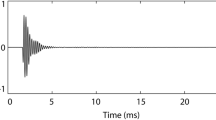Abstract
Echolocation is typically associated with bats and toothed whales. To date, only few studies have investigated echolocation in humans. Moreover, these experiments were conducted with real objects in real rooms; a configuration in which features of both vocal emissions and perceptual cues are difficult to analyse and control. We investigated human sonar target-ranging in virtual echo-acoustic space, using a short-latency, real-time convolution engine. Subjects produced tongue clicks, which were picked up by a headset microphone, digitally delayed, convolved with individual head-related transfer functions and played back through earphones, thus simulating a reflecting surface at a specific range in front of the subject. In an adaptive 2-AFC paradigm, we measured the perceptual sensitivity to changes of the range for reference ranges of 1.7, 3.4 or 6.8 m. In a follow-up experiment, a second simulated surface at a lateral position and a fixed range was added, expected to act either as an interfering masker or a useful reference. The psychophysical data show that the subjects were well capable to discriminate differences in the range of a frontal reflector. The range–discrimination thresholds were typically below 1 m and, for a reference range of 1.7 m, they were typically below 0.5 m. Performance improved when a second reflector was introduced at a lateral angle of 45°. A detailed analysis of the tongue clicks showed that the subjects typically produced short, broadband palatal clicks with durations between 3 and 15 ms, and sound levels between 60 and 108 dB. Typically, the tongue clicks had relatively high peak frequencies around 6 to 8 kHz. Through the combination of highly controlled psychophysical experiments in virtual space and a detailed analysis of both the subjects’ performance and their emitted tongue clicks, the current experiments provide insights into both vocal motor and sensory processes recruited by humans that aim to explore their environment by echolocation.





Similar content being viewed by others
References
Au WWL (1993) The sonar of dolphins. Springer, New York
Bassett IG, Eastmond EJ (1964) Echolocation: measurement of pitch versus distance for sounds reflected from a flat surface. J Acoust Soc Am 36:911–916
Bernstein LR, Trahiotis C (2002) Enhancing sensitivity to interaural delays at high frequencies by using "transposed stimuli". J Acoust Soc Am 112:1026–1036
Covey E (2005) Neurobiological specializations in echolocating bats. Anat Rec A Discov Mol Cell Evol Biol 287:1103–1116
Denzinger A, Schnitzler HU (1998) Echo SPL, training experience, and experimental procedure influence the ranging performance in the big brown bat, Eptesicus fuscus. J Comp Physiol [A] 183:213–224
Ewert SD, Kaiser K, Kernschmidt L, Wiegrebe L (2012) Perceptual sensitivity to high-frequency interaural time differences created by rustling sounds. J Assoc Res Otolaryngol 13(1):131–143
Goerlitz HR, Geberl C, Wiegrebe L (2010) Sonar detection of jittering real targets in a free-flying bat. J Acoust Soc Am 128:1467–1475
Gould E (1965) Evidence for echolocation in the Tenrecidae of Madagascar. Proc Am Phil Soc 109:352–360
Gould E, Novick A, Negus NC (1964) Evidence for echolocation in shrews. J Exp Zool 156:19–37
Griffin DR (1974) Listening in the dark: acoustic orientation of bats and men. Dover Publications Inc., New York
Houtsma AJM, Smurzynski J (1990) Pitch identification and discrimination for complex tones with many harmonics. J Acoust Soc Am 87:304–310
Kellogg WN (1962) Sonar system of the blind. Science 137:399–404
Kohler I (1964) Orientation by aural clues. Am Found Blind, Res Bull 4:14–53
Konishi M, Knudsen EI (1979) The oilbird: hearing and echolocation. Science 204:425–427
Moore BCJ (1997) Introduction to the psychology of hearing. Academic Press, San Diego
Murchison AE (1980) Detection range and range resolution of porpoise. In: Busnel RG, Fish JF (eds) Animal sonar systems. Plenum Press, New York, pp 43–70
O'Neill WE, Suga N (1979) Target range-sensitive neurons in the auditory cortex of the mustache bat. Science 203:69–73
Palmer SE (1999) Vision science: photons to phenomenology. MIT Press, Cambridge
Patterson RD (1976) Auditory filter shapes derived with noise stimuli. J Acoust Soc Am 59:640–654
Plack CJ, Oxenham AJ, Fay RR (2005) Pitch: neural coding and perception. Springer, New York
Popper AN, Fay RR (1995) Hearing by bats. Springer, New York
Rice CE (1967) Human echo perception. Science 155:656–664
Rice CE, Feinstein SH (1965) Sonar system of the blind: size discrimination. Science 148:1107–1108
Schenkman BN, Nilsson ME (2010) Human echolocation: blind and sighted persons' ability to detect sounds recorded in the presence of a reflecting object. Perception 39:483–501
Siemers BM, Schauermann G, Turni H, von Merten S (2009) Why do shrews twitter? Communication or simple echo-based orientation. Biol Lett 5:593–596
Simmons JA (1973) The resolution of target range by echolocating bats. J Acoust Soc Am 54:157–173
Stenfelt S, Goode RL (2005) Bone-conducted sound: physiological and clinical aspects. Otol Neurotol 26:1245–1261
Supa M, Cotzin M, Dallenbach KM (1944) Facial vision the perception of obstacles by the blind. Am J Psychol 57:133–183
Teng S, Puri A, Whitney D (2011) Ultrafine spatial acuity of blind expert human echolocators. Exp Brain Res 216:483–488
Wiegrebe L, Krumbholz K (1997) Temporal integration of transient stimuli and the auditory filter. Br J Audiol 31:107–108
Acknowledgments
The authors would like to thank Daniel Kish and Magnus Wahlberg for many fruitful discussions on the topic of human echolocation. We would also like to thank the anonymous reviewers for the detailed and constructive comments. This work was supported by a grant from the ‘Deutsche Forschungsgemeinschaft’ (Wi 1518/9) to L.W.
Author information
Authors and Affiliations
Corresponding author
Rights and permissions
About this article
Cite this article
Schörnich, S., Nagy, A. & Wiegrebe, L. Discovering Your Inner Bat: Echo–Acoustic Target Ranging in Humans. JARO 13, 673–682 (2012). https://doi.org/10.1007/s10162-012-0338-z
Received:
Accepted:
Published:
Issue Date:
DOI: https://doi.org/10.1007/s10162-012-0338-z




